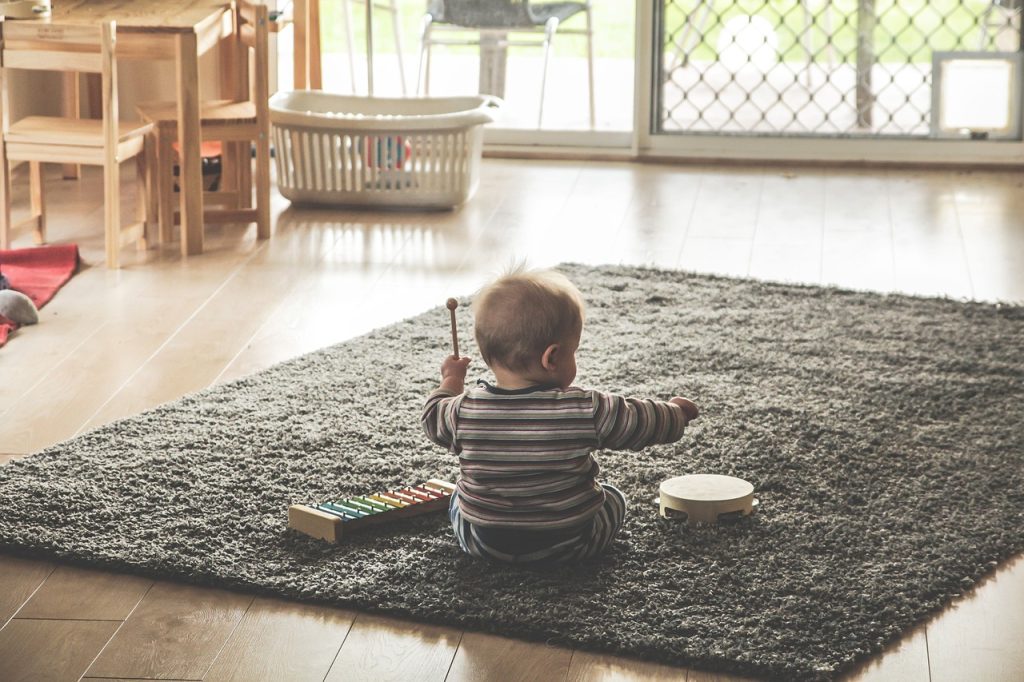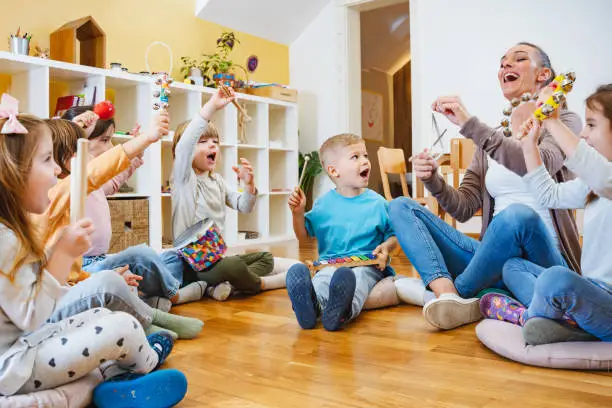Musical Play in Early Childhood, an Essential Aspect!
- Gabrielle Vézina, Master’s student in Education, Psychopedagogy Profile. Department of Education Sciences, Université du Québec à Trois-Rivières
- Aimée Gaudette-Leblanc, PhD candidate in Music Education, Faculty of Music, Université Laval. Professor, Department of Education Sciences, Université du Québec à Trois-Rivières
The sonic world of toddlers

Toddlers love playing with sounds. Whether alone or with others, indoors or outdoors, they delight in manipulating their voices and creating sounds with the objects around them. Have you ever taken the time to listen to these games? What have you observed?
This article delves into the realm of musical play. First, we take care to define what play is and explain how the act of playing allows children to develop and learn. Then, we introduce the concept of musical play, providing various examples observed in the research conducted by our colleagues. Finally, we invite you to explore different forms of musical play.
What is play?
Play is an enjoyable activity that allows a child to experience pleasure and joy. It is an activity in which the child willingly participates, motivated by a desire to learn, discover, and understand the world around them (Zosh et al., 2017). Although usually initiated by the child, play can also be guided or directed by adults (Pyle & Danniels, 2017). That being said, regardless of the context in which it occurs, the true essence of play lies in the process – the journey, if you will – rather than the destination or result (Lemay et al., 2019; Pyle and Danniels, 2017).
Key takeaway! Through play, a child develops and learns, regardless of the purpose of the game.
How does play enable a child to develop and learn?
As explained by Lemay and colleagues (2019), “(…) play allows the child to mobilize a set of motor, social, emotional, cognitive, and language skills, contributing to their overall development” (Lemay et al., 2019, p. 39).
When playing, the child draws on their previous knowledge. They form hypotheses and experiment with different actions in various contexts (e.g., at home, at school, in daycare). They engage with others, communicate their ideas, regulate themselves, and express themselves. For example, consider Noah and Mathis discovering the sound of sandpaper rubbed against their wooden blocks. At that moment, these two children are not just building a house; they are also the conductors of a sound experiment, asking questions, forming hypotheses… Is this a familiar sound? What does this sound remind me of? This game, often seen as a construction activity, is undoubtedly also a musical game.
Key takeaway! Toddlers learn by being active and, if possible, accompanied. To learn to distinguish sounds (e.g., loud sounds vs. soft sounds), they play with the materials at their disposal!
What is musical play?

Musical play in toddlers includes “musical activities initiated by children and/or in which children choose to participate with others, voluntarily” (Marsh and Young, 2015, p. 462, free translation). These activities are enjoyable, intrinsically motivated, and directed by the players. They can take place in various contexts (Creech et al., 2020), whether at home, in daycare, at school, in the park, or in the yard (Gaudette-Leblanc et al., 2020). Consider, for example, Jules playing with his voice at bedtime, alone in his bed. He babbles and improvises rhythms and melodies that incorporate different musical elements from songs that were previously sung to him. The same goes for Alfie, who sings using learned lyrics, invented words, and/or meaningless words while eating, washing his hands, putting on his shoes, and playing in the yard (Dean, 2019).
Key takeaway! Whether practiced solo or with others, musical play allows children to express themselves, regulate themselves, and apply their musical and language skills (Sole, 2017). When playing musically, children unknowingly learn about music in a completely informal manner, in a familiar environment (Creech et al., 2020).
Is musical play observed in different contexts?
Absolutely! Musical play is not confined to the home. Indeed, it can resonate just as much in daycare (e.g., Young, 2002; 2004; 2006) and at school (Niland, 2019). For example, Kyle, 2 years old, uses his voice and sings to propel his wooden train in the outdoor daycare yard (Young, 2004). Further on, Charlotte and Flavie, both 5 years old, sing and engage in hand-clapping games in the schoolyard (Niland, 2019). These examples demonstrate that children spontaneously merge sound and action to enrich their play experience.
Key takeaway! The aforementioned examples highlight that young children often play with their voices. And what is remarkable is that they do it… while playing! It is not uncommon to hear them produce sounds when manipulating objects or even when participating in a game of hide-and-seek! Simply listen carefully to hear them play. And if we listen attentively… what will we hear? It will then be possible to realize that, in fact, the child plays with sounds in different ways.
Did you know that there are different forms of musical play?

Indeed, by observing children’s play, scientists have identified six distinct forms of musical play in which little music lovers engage: exploration play, interaction play, construction play, symbolic play, kinesthetic play, and rule play (Marsh and Young, 2015; Niland, 2009; Ockelford and Voyajolu, 2015, 2017). Can you associate each of the following statements with one of these types of play? Your turn to play!
- The child responds to sounds produced by others.
- The child produces sounds by manipulating objects.
- The child represents the sounds they perceive through movement.
- The child manipulates sounds they know and creates new ones.
- The child plays with sounds following an established structure or sequence.
- The child plays with sounds to enrich pretend play, a scenario, or a scene.
When life becomes a game and music for the child!
In conclusion, musical play is an integral part of a child’s life from birth. Toddlers explore and discover sounds, creating them sometimes alone, sometimes with others. While various musical games are promoted by adults, such as interactive and kinesthetic play, others, like exploration play, are often initiated by the child.
Unfortunately, some constraints, such as a lack of space, a lack of time, and sometimes adults’ intolerance towards sounds produced by children, sometimes diminish the opportunities young children have to play with sounds (Marsh and Young, 2015). So, how can we create an environment where musical play is not only allowed but also celebrated?
We invite you to explore these sonic worlds of children through these inspiring videos and perhaps consider listening a bit more attentively at the next concert of the little maestros!
Video 1 – Playing musically with free and versatile materials
In this video, several children explore sounds by manipulating free and versatile materials placed on a table outdoors.
Video 2 – Playing musically with water
Here, young children explore musical play with water, bubbles, and various objects.
Video 3 – Playing musically with everyday objects
In this video, we see several children exploring the sounds of instruments made available to them, sometimes alone, sometimes in small groups, indoors and outdoors. We understand well how musical play organizes itself without being directed by adults
Learning & Development: Music – With intent | Nursery World
Learning & Development: Music – Surround sound? | Nursery World
References
Creech, A., Varvarigou, M. et Hallam, S. (2020). Contexts for music learning and participation: Developing and sustaining musical possible selves. Springer Nature. https://doi.org/10.1007/978-3-030-48262-6
Dean, B. (2019). Spontaneous Singing and Musical Agency in the Everyday Home Lives of Three- and Four-Year-Old Children. Dans S. Young et B. Ilari (dir.), Music in Early Childhood: Multi-disciplinary Perspectives and Inter-disciplinary Exchanges (pp. 103-118). Cham: Springer International Publishing. https://doi.org/10.1007/978-3-030-17791-1_7
Gaudette-Leblanc, A., Boucher H. et Duval, S. (2021). Faire de la musique… un jeu d’enfant. Revue préscolaire, 59(1), 58-59.
Gaudette-Leblanc, A., Leclaire, É. et Point, M. (2020). S’initier à la musique en plein-air. Revue préscolaire, 58(4), 65-66.
Lemay, L., Bouchard, C. et Landry, S. (2019). Jouer, apprendre et se développer. Dans C. Bouchard (dir.), Le développement global de l’enfant de 0 à 6 ans en contextes éducatifs (pp. 37-74). Presses de l’Université du Québec.
Marsh, K, et Young, S. (2015) Musical play, in G. E. McPherson (ed.), The Child as Musician: A handbook of musical development, 2éd, (pp. 462-484) Oxford University Press. https://doi.org/10.1093/acprof:oso/9780198744443.003.0025
Niland, A. (2009). The power of musical play: The value of play-based, child-centered curriculum in early childhood music education. General Music Today, 23(1), 17-21. https://doi.org/10.1177/1048371309335625
Niland, A. (2019). Singing and playing with friends: Musical identities and peer cultures in early years settings. Dans S. Young et B. Ilari (dir.) Music in early childhood: Multi-disciplinary perspectives and inter-disciplinary exchanges (pp. 21-37). Marilyn Fleer et Ingrid Pramling Samuelsson. https://doi.org/10.1007/978-3-030-17791-1_2
Ockelford, A. et Voyajolu, A. (2015). With intent. Nursery World, (21), 18-19. https://doi.org/10.12968/nuwa.2015.21.18
Ockelford, A. et Voyajolu, A. (2017). Musical play and play through music in early childhood. Dans T. Bruce, P. Hakkarainen et M. Bredikyte (Dir), The Routledge international handbook of early childhood play. (pp. 395–406). Routledge/Taylor & Francis Group. https://doi.org/10.4324/9781315735290-36
Pyle, A. et Danniels, E. (2017). A continuum of play-based learning: The role of the teacher in play-based pedagogy and the fear of hijacking play. Early education and development, 28(3), 274-289. https://doi.org/10.1080/10409289.2016.1220771
Sole, M. (2017). Crib song: Insights into functions of toddlers’ private spontaneous singing. Psychology of Music, 45(2), 172-192. https://doi.org/10.1177/0305735616650746
Voyajolu, A., et Ockelford, A. (2016). Sounds of Intent in the Early Years: A proposed framework of young children’s musical development. Research Studies in Music Education, 38(1), 93–113. https://doi.org/10.1177/1321103X16642632
Young, S. (2002). Young Children’s Spontaneous Vocalizations in Free-Play: Observations of Two- to Three-Year-Olds in a Day-Care Setting. Bulletin of the Council for Research in Music Education (152), 43-53.
Young, S. (2004). Young children’s spontaneous vocalising: Insights into play and pathways to singing. International journal of early childhood, (36), 59-74. https://doi.org/10.1007/BF03168200
Young, S. (2006). Seen but Not Heard: Young Children, Improvised Singing and Educational Practice. Contemporary Issues in Early Childhood, 7(3), 270-280. https://doi.org/10.2304/ciec.2006.7.3.270
Zosh, J. N., Hopkins, E. J., Jensen, H., Liu, C., Neale, D., Hirsh-Pasek, K., … et Whitebread, D. (2017). Learning through play: a review of the evidence. Billund, Denmark: LEGO Fonden.